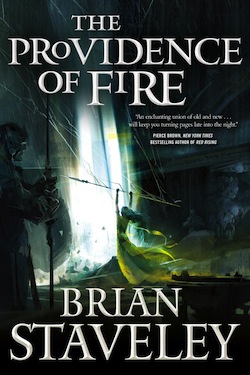Attracting complaint and acclamation in almost equal measure, Brian Staveley’s debut proved precisely as divisive as I imagined it might: there were those readers ready to invest in its incredible potential, and there were those bored by its borderline by-the-numbers nature.
The Emperor’s Blades undoubtedly did suffer from some significant issues—its manifest mistreatment of women in particular irked this critic—but at the same time, I found in the fantasy saga’s first volume quite a lot to like. What little there was of its world was wonderful; the cosmic horror of its monsters was a welcome exception to certain unwritten traditions; meanwhile most, if not all of the narrative’s central characters were well developed by the conclusion of what was an engrossing chronicle overall.
At the end of the day, I dare say I enjoyed The Emperor’s Blades. My reservations, however, came back to me in a flash when the time came to see about the sequel. By taking the better part of a hundred pages to begin, it doesn’t put its best foot forward, I’m afraid… but beyond that? Boy oh boy. The Providence of Fire stands as a lesson in a sense: that great things can spring from small beginnings.
The Providence of Fire picks up—when it picks up—right where The Emperor’s Blades left off: with Kaden, heir to the entire Annurian empire since the assassination of his father, and Valyn, captain of a Wing of rebel Kettral riders—and his elder sibling’s saviour—as brothers in both blood and arms at last.
Valyn is still struggling to understand the consequences of his close shave with the slarn:
Like the rest of the Kettral, any member of Valyn’s Wing could now see in the shadows and hear things at the edge of hearing. They were all stronger than they had been, too, tougher, as though some of the slarn’s wiry strength had been sewn into their flesh when they seized the eggs and drank. But only Valyn had found the dark egg, the one guarded by the king himself.
[…]
Like the others, he’d found his sight and hearing suddenly, if subtly, enhanced. He could hear small rocks clattering down the cliffside a hundred paces distant, could make out the pinions on the hawks that wheeled overhead… but there was more. Sometimes an animal fury clamped down on his heart, a savage desire, not just to fight and kill, not just to see the mission done, but to rend, to hack, to hurt.
Kaden, in comparison, feels his physical weakness keenly:
He could paint, sit in meditation, or run for days over rough trail, but painting, running and meditation were meagre skills when set against the machinations of the men who had murdered his father, slaughtered the Shin monks, and very nearly killed him as well. Not for the first time, he found himself envying Valyn’s training.
But the emperor-in-waiting’s training has prepared him for the world in other ways. Seasons of study with the Shin have enabled Kaden to make use of the kenta: a network of ancient gates those who have attained absolute balance can use to travel from place to place instantaneously.
To wit, together with his love interest Triste and Rampuri Tan, his instructor at Ashk’lan, Kaden takes leave of his brother and the others, the better to make a few new friends. “I will not be […] kept safe while others fight my battles,” he holds. “The Csestriim killed my father; they tried to kill me and Valyn. If I’m going to fight back, I need what the Ishien know. More, I need to meet them, to forge some sort of alliance.”
Would that they also wanted one…

In any case, having bid his brother goodbye, Valyn and his Wing—now traitors in the eyes of their trainers—are practically stranded in Vash, the hardscrabble lands North of the empire’s territory. There, they learn that the once isolated barbarians who roamed these plains in the past appear to have joined forces under the command of a man—more or less—who means to bring Annur to its knees.
Annur—the seat of power of the aforementioned Malkeenians—is where we find Adare: a sister, a princess, and the unwitting lover of the man who had Emperor Sanlitun slaughtered—that’s the regent Ran il Tornja, readers—yet without question the weakest of The Emperor’s Blades’ slim selection of perspectives. In the five of the fifty chapters she featured in, all she served to do, as I put it in my review, was “push the plot along and […] have some hanky-panky,” though that book’s conclusion gave me reason to believe Adare would have more to do in book two.
It’s my pleasure to tell you: she does.
Hers is, if anything, The Providence of Fire’s predominant POV. Finally we find her at the centre of events, as opposed to the bedchambers beside said; from the first, in fact, Adare is an agent of change in Staveley’s superior sequel rather than the royal bauble she was.
Brilliantly, she begins the book by abandoning Annur and all it offers her to travel to Olon alongside the thousands of pilgrims her own dubious decisions drove to the depths of despair. She goes directly to her enemy’s headquarters, not unaware of the grave danger her presence represents, in order to raise a religious army against the reigning regent:
What she was planning felt like madness, a desperate gambit to leverage the instability of the empire itself in order to reclaim the Unhewn Throne for her family, and yet it wasn’t really the end of the Malkeenian line that worried her. Despite her own eyes, Adare had no illusions about Malkeenian sanctity. Over the centuries, her family had furnished dozens of emperors, some capable, some less so. The idea of leaving the empire to Il Tornja, however… that seemed both a dangerous and cowardly course.
Though she has a substantially more… substantial part to play in The Providence of Fire than she did in its problematic predecessor, Staveley’s characterisation of Adare is still an issue. Initially, “her ignorance [is] infuriating,” and later on, I found myself frustrated by shades of The Emperor’s Blades as she allows herself “to be led like a docile beast” by the very man she sets out to unseat.
If there’s a weak link among the text’s perspectives, however, it has to be Valyn’s scattershot share of the gathering narrative. Staveley spent so long bringing him and his kin together in book one that it’s kind of crushing to see the pair go their separate ways so soon. This rather robs our Wing commander of his role in the whole, so while Kaden’s development continues apace, Valyn’s simply stalls.
It’s a way to embiggen the world he’s wasted, but that isn’t to say Staveley’s determination to explode the story’s scope goes unnoticed. On the contrary, The Providence of Fire feels markedly more epic precisely because of the author’s efforts… I just wish this improvement hadn’t cost us a central character.
Like the exponentially more textured setting, then, The Providence of Fire is both bigger than The Emperor’s Blades and leaps and bounds better. Staveley systematically addresses the most damning drawbacks of his debut, and if a couple of new problems appear in their place—aside the slow start and the pointlessness of Valyn’s part, some key scenes are so rushed that their significance is as good as guaranteed to go unnoticed—I have renewed faith in him to fix them in the future.
Brian Staveley mightn’t be reinventing the wheel here—in that sense, and a number of others, the text is Sandersonesque—but The Providence of Fire is ultimately a ton of fun, and that’s fine. Me, I’m a fan of fun. You want some?
You can read the first six chapters of The Providence of Fire for free on Tor.com.
The Providence of Fire is out on January 13, 2015 from Tor Books in the U.S. and January 15, 2015 from Tor UK.
Niall Alexander is an extra-curricular English teacher who reads and writes about all things weird and wonderful for The Speculative Scotsman, Strange Horizons, and Tor.com. He’s been known to tweet, twoo.










